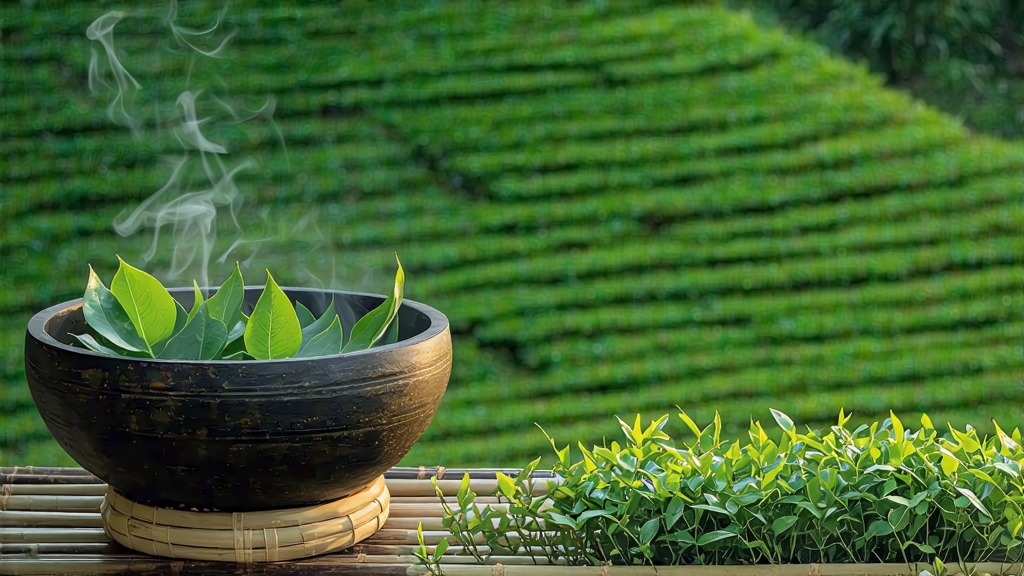
Longjing, literally “Dragon-Well,” is not merely a green tea; it is a liquid manuscript of Chinese aesthetics, geography, and etiquette. Its fame began in the Tang dynasty when the monk-poet Lu Yu listed the spring beside Hangzhou’s Lion Peak as one of the nation’s twenty finest water sources. By the Song court it had become tribute, carried by canal barges to Kaifeng in sealed bamboo tubes lined with lotus leaves. The Qianlong Emperor’s 18th-century visit sealed its myth: legend says he plucked leaves himself beneath the rain-bent branches of the Hugong Temple tea grove, then bestowed the eighteen imperial bushes as state relics still guarded today.
Geography is destiny. The Xihu (West Lake) micro-basin enjoys a lacework of mist rising from the water, filtering spring sunlight into a soft, diffused glow that slows photosynthesis and builds amino acids, especially L-theanine, responsible for Longjing’s famous “sweet umami behind the nut.” The quartz-rich sandstone soil drains quickly yet holds warmth, forcing roots to dive deep for minerals that tighten cell walls and concentrate fragrance. Within Xihu, five core villages—Shífēng (Lion Peak), Méijiāwǔ, Wēngjiāshān, Hǔpáo (Tiger-Running), and Lóngjǐng proper—offer subtle dialects of flavor: Shífēng yields a peppery orchid note, Méijiāwǔ a fennel-like creaminess, while Hǔpáo carries the faint scent of the spring’s legendary running-tiger minerals.
True Longjing is Shi Shi, “real time,” plucked before Qingming festival when each bud still wears its winter down. Pickers use thumbnail, not finger, to avoid oxidizing bruises; the ideal pick is the “sparrow’s tongue”—one unfurled leaf clasping a downy bud, weighing 0.3 g and measuring 2.5 cm. Forty thousand such tongues make one liang (50 g) of finished tea, a ratio that explains both its price and its poetry.
The craft is a duet between hand and wok. A seasoned tea master works a 200 °C cast-iron pan bare-handed, relying on calloused fingertips to read temperature through the leaf. The ten-step choreography—grab, press, rub, fling, shake—lasts only twenty-five minutes but is compressed with centuries of intuition. “Green first, then aroma, then shape,” masters recite. Initial high heat kills green enzymes; mid heat coaxes grassy volatility away; final gentle warmth sets the famous flat sword shape. The leaf must leave the wok at 6 % moisture, flexible enough to survive shaping yet brittle enough to snap crisply when cool. Over-firing produces burnt sesame; under-firing leaves a raw bean note—faults detectable to a trained nose within 0.3 seconds of sniffing.
Grading follows a sensory triangulation: appearance, aroma, infusion. Top-grade Mingqian (pre-Qingming) tea swims erect in a glass, each leaf hovering like a miniature green jade tablet, then slowly sinks tail-first, a motion called “the standing needle.” The liquor is the color of early spring willow catkins—what poets call “lucid yellow among green.” First aroma is fresh corn milk; second infusion releases toasted pine nut; third, a returning orchid sweetness that lingers on the upper palate like distant temple bells. Lesser grades, picked after Guyu grain-rain, darken faster in cup and carry a rougher straw note.
Water is half the tea. Hangzhou old-timers trek to Hupao spring at dawn, believing the rising qi of running water awakens leaf spirit. For international brewers, low-TDS spring water at 80 °C is the safest proxy. Pre-heat a tall, thin glass to 50 °C; add 3 g leaf (a level teaspoon) per 150 ml; pour water in a high, thin stream to agitate. Do not cover—Longjing needs oxygen to unfold. Steep 90 seconds, then sip while tilting the glass so leaf kisses lip. Good leaf will yield four infusions: the first for fragrance, the second for flavor, the third for sweetness, the fourth for memory. After tasting, press a leaf between white paper: intact vein lattice and intact serrated edge are hallmarks of hand-picking;